Sri Lanka Seeks at Least $1.9 Million from Owner of Fire-hit Tanker
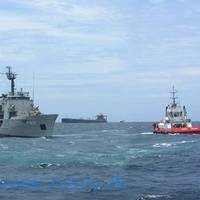
Sri Lanka is seeking at least 340 million rupees ($1.9 million) from the owner of the stricken oil supertanker New Diamond for assistance given to the vessel since it caught fire on Sept. 3, the coordinating officer to the country's attorney general said.Nishara Jayaratne said the cost was for services provided by various departments including the Sri Lankan navy, air force, ports authority and Marine Environment Protection Authority, among others, up until Sept. 15.The fully-loaded vessel is still in Sri Lankan waters…
Sri Lanka Plugs Leak on Fire-stricken Supertanker
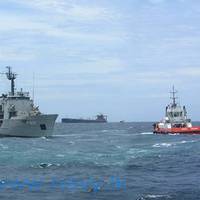
Sri Lanka has initiated repair work on the ruptured fuel oil tank in the engine room of a stricken fully loaded oil supertanker after plugging the leak, the country's Navy said.The supertanker is currently 52 nautical miles (96 kms) from the Sri Lankan coast, Navy spokesman Indika de Silva said. "Salvors are on board, they plugged the leak and the repair is still going...They have vacated the ruptured tank and transferred the dirty water into the ballast section," de Silva told Reuters. A fire broke out in the engine room of the Greek-owned New Diamond tanker on Sept.
Sri Lanka: Fire-hit Tanker Towed Further Offshore as Wind Picks Up
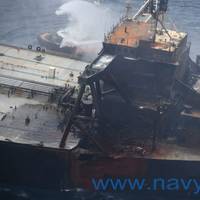
The Sri Lankan navy has towed a fire-stricken supertanker further out to sea to keep it off the coast of the Indian Ocean island after the wind picked up strength and changed direction, a spokesman said on Thursday.The tanker, loaded with 2 million barrels oil, was 50 nautical miles (95 km) from the east coast and moving in a northerly direction, the navy spokesman, Indika de Silva, said. Earlier, it had been headed southwest.The stricken vessel has raised fears of an environmental disaster…
Who Pays for Mauritius Oil Spill and How Much?
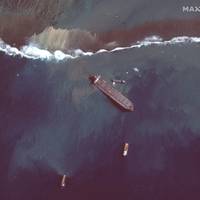
A Japanese bulk carrier struck a coral reef off the Indian Ocean island nation of Mauritius on July 25, spilling about 1,000 tonnes of fuel oil and triggering a state of "environmental emergency".Scientists say the spill is the country's worst ecological disaster, killing wildlife and damaging pristine waters that attract tourists from around the globe. The full impact is still unfolding. As residents scramble to mop up the oil slicks, they are seeing dead eels and fish floating…
Mauritius Oil Spill Could Impact Country's Economy for Decades
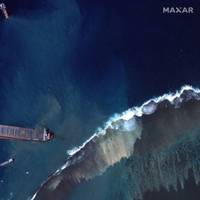
Some corals have lived for centuries at the fringes of Mauritius. Now smothered for days in heavy fuel oil spilled from a wrecked Japanese ship nearby, parts of those reefs may be in trouble.The full impact of the toxic spill is still unfolding, scientists say. As the Indian Ocean island's residents scramble to mop up the oil slicks and clumps, they are seeing dead eels and fish floating in the water, as fuel-soaked seabirds limp onto shore.Satellite images also show the 1,000…
Brazil Targets Greek Tanker in Pollution Probe
Brazilian investigators said on Friday a Greek-flagged ship carrying Venezuelan crude was the source of oil tarring thousands of kilometers of coastline over the past two months.While prosecutors and police did not name the vessel, a prosecutors' document obtained by Reuters identified the ship as the Bouboulina, owned by Greece's Delta Tankers Ltd. Police said the tanker appears to have spilled the crude about 700 km (420 miles) off Brazil's coast between July 28-29, bound for Singapore with oil loaded at Venezuela's San José terminal.Delta Tankers did not immediately respond to a request for comment.Brazil's solicitor general said the country would seek damages in the case…
Brazil Federal Police Investigate Greek Ship in Connection with Oil Spill
Brazil's federal police on Friday announced a potential breakthrough in the investigation into the causes of a mysterious oil spill that has baffled authorities and Brazilians for about two months.Police said they were investigating a Greek-flagged ship allegedly responsible for the oil spill, which they claim may have occurred about 700 km (420 miles) off the Brazilian coast between July 28-29 after the vessel made a stop in Venezuela.In a statement, federal police said they were carrying out search warrants at addresses linked to a company of Greek nationality.Brazilian authorities said they had also requested cooperation from international agencies…
Brazil: Oil Slicks on Beaches Likely Criminal Acts
Brazil President Jair Bolsonaro said on Tuesday that mysterious oil slicks polluting the country's northeastern beaches were likely to have been left there criminally.Had the oil originated from a shipwreck, as Bolsonaro posited on Monday, it would still be seeping onto the beaches, he said.The oil has washed up in recent weeks on more than a hundred beaches in nine northeastern states from Maranhao down to Bahia. Its origin has yet to be explained.Reporting by Pedro Fonseca
AIS Provide Skidmarks on the Ocean
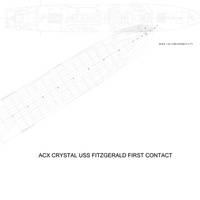
Many years ago, I received a call from an attorney who wanted me to get on the plane to Houston right away to take a look at damage on two ships that had collided in the approaches to Houston.He told me that both vessels had become confused, had started to turn and managed to occupy the same bit of ocean at the same time. His preliminary analysis indicated that, if he could prove the other vessel turned first, his vessel was in the clear.This was in the late eighties or early nineties, the course recorders had not been running, there was no VDR, and no electronic navigation record.
New Oil Spill Tech Solutions Put to the Test
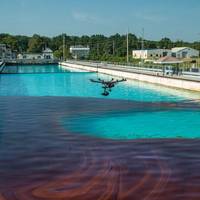
No two oil spill response operations are the same. Each can present new and even tougher challenges for spill responders as they detect, contain and recover spilled oil. Diverse aspects affecting oil spill response operations can be the physical environment, spill monitoring, use of chemical dispersants, and the availability of proper technology for the situation.Some challenges have been met through research and technology development of techniques for dealing with spills. However…
Oil from Sunken Tanker Sanchi Reached Japan's Shores
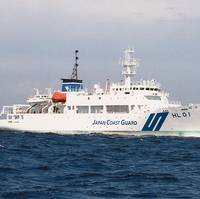
Oil that reached islands in southern Japan earlier this month is highly likely to have come from the sunken Iranian tanker Sanchi, the Japan Coast Guard said on Thursday. Samples of oily matter that washed up on Feb. 8 on the shores of the Okinoerabu and Yoron islands in the Amami chain were found to be linked to the Sanchi's sinking, the Coast Guard said. The Sanchi sank on Jan. 14 after colliding with a freighter on Jan. 6 in the world's worst oil tanker disaster in decades.
Oil From Sunken Iranian Tanker May Have Reached Japan
Clumps of oil have washed up on the shores of southern Japan and there are fears they may be leaking from an Iranian crude tanker than sank in the world's worst such disaster in decades, the Japanese Coast Guard said on Friday. Black clumps have reached the shores of the island of Amami-Oshima, a coast guard official told Reuters by phone. Authorities are checking to see if it is from the Sanchi (IMO:9356608) tanker that sank in the East China Sea last month, after being alerted to its presence by the public. The government had set up a special unit within Prime Minister Shinzo Abe's office to coordinate Japan's response to the latest development, Chief Cabinet Secretary Yoshihide Suga told reporters.
China: Sunken Tanker Sanchi May be Leaking HFO
A sunken Iranian oil tanker may be leaking heavy bunker fuel as well as light oil off the east coast of China and the best remedy was to recover the vessel, officials said on Friday. It was unclear how much bunker fuel was left aboard the tanker when it sank on Sunday after being ablaze for days but experts estimated it may have been carrying about 1,000 tonnes at the time of collision. "There have been multiple appearances of oil slicks of different sizes and types at the sinking spot and nearby... the slicks exceeded 200 sq kilometres (77 sq miles) on Thursday," Huo Chuanlin, of the State Oceanic Administration's Ecological Protection Department, told reporters. It was not immediately clear where the oil could wash up or the extent of the damage it could cause.
Iranian Tanker Produces 2 Slicks in East China Sea
An Iranian oil tanker that sank in the East China Sea has left two oil slicks covering a combined 109 square km (42 square miles), the Chinese government said, as maritime police scoured for damage and prepared to explore the wreck. Satellite imaging showed a slick of 69 square km (26.6 square miles) and a second 40 square km (15.4 square miles) slick, which is less thick and not as concentrated, the State Oceanic Administration (SOA) said in a statement late on Tuesday. The large tanker Sanchi (IMO:9356608) sank in the worst oil ship disaster in decades on Sunday, raising worries about damage to the marine ecosystem. The bodies of two sailors were recovered from the ship while a third body was pulled from the sea near the vessel. The remaining 29 crew of the ship are presumed dead.
Limitless Salvage

Whether driven by treasure hunting or environmental protection, the days of forgotten wrecks, even at great depths, is past. It seems like every month we see reports of long-lost maritime wrecks being discovered on the ocean bottom and treasures being salvaged from great depths. We also hear regularly of oil being recovered from sunken wrecks. There is now no practical limit to the ability to recover objects from the sea floor, regardless of depth, currents, weather, or other obstacles. The only existing obstacle seems to be financing - and costs are decreasing regularly.
SoCal Beach Cleanup Could Take Months
The U.S. Coast Guard captain overseeing cleanup of oil spilled from a pipeline rupture that closed two California state beaches and fouled offshore waters near Santa Barbara said on Thursday it may take months to restore the area to its natural condition. Up to 2,500 barrels (105,000 gallons) of crude petroleum, according to latest estimates, gushed onto San Refugio State Beach and into the Pacific about 20 miles (32 km) west of Santa Barbara on Tuesday when an underground pipeline that runs along the coastal highway burst. As much as a fifth of the amount was believed to have reached the ocean, leaving oil slicks that stretched for more than 9 miles (15 km) along the coast.
Responder Immunity

Not long after specialized tank ships were developed, enabling the carriage of large quantities of oil and petroleum products, groundings, collisions, and other casualties started causing significant oil spills. In those early days, there was no financial incentive to clean up such spills. To the extent that there was a response, it was often by Good Samaritans, a term derived from a parable found in the Bible at Luke 10:25-37 about a stranger from Samaria who, with no thought of reward, came to the aid of an injured robbery victim in Judah.
Canada Seeks Tightened Marine Oil Spill Plan
Canada moved on Tuesday to strengthen its response plan for oil spills at sea ahead of the development of new pipelines that would sharply increase tanker traffic in Canadian waters if they are built. Among the new measures, the federal government said it would remove a per-incident liability cap on a domestic clean-up fund, which means that all the money in the fund could be made available to clean up a single spill. It also pledged to cover spill costs if clean-up funds were exhausted. It also said it will lift its ban on the use of dispersants in cases when using them offers a net environmental benefit. Dispersants are chemicals that break down oil slicks but can also harm marine life.
Chariot Oil & Gas Investments & Woodside Sign Agreement
Chariot Oil & Gas Limited (AIM: CHAR), the Atlantic margins focused oil and gas exploration company, informed that its wholly owned subsidiary, Chariot Oil & Gas Investments (Morocco) Ltd., has signed a farm-out agreement with a wholly owned subsidiary of Woodside, Australia's largest independent exploration & production company. Following completion of this agreement, which is subject to the approval of the Moroccan authorities, Woodside will hold a 25% equity interest in the Rabat Deep Offshore permits I-VI, Morocco, in return for paying 100% of the 3D seismic acquisition and processing costs incurred across the licence by Chariot, as well as all back costs and a carry on planned multibeam side-scan sonar and seabed coring.
Satellite Radar

With the ocean moving more than 90% of world commerce, keeping it secure is of vital importance – yet our ability to monitor activity at sea is somewhat more challenging than on land given the vastness of the oceans. Also many maritime monitoring systems rely on ships to ‘opt-in’, that can leave potentially risky blind spots in our picture of maritime traffic. This article, derived from a presentation that David Beard of the Defence Science and Technology Laboratory gave at the recent DMC and NovaSAR International Conference…
New Oil Spill Response Equipment

The new SECurus system uses infrared cameras and radar to allow oil slicks to be monitored and collected. The new system makes it easier to see and remove the oil both during the day and at night, which is particularly important in the far north where there is little daylight in the winter months. The new system is operated from a vessel, and utilises both an infra-red camera and a newly developed radar system to monitor and collect information about the oil-spill. Normally aeroplanes and helicopters are used to monitor the situation, but these are not always available.
NRL Models Deepwater Horizon Oil Spill
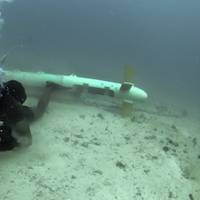
Dr. Jason Jolliff is an oceanographer with the U.S. Naval Research Laboratory (NRL). "The emphasis here," he says, "is on developing models of the ocean environment to help the naval warfighter." His most recent paper, published in Ocean Modeling (March 2014), shows NRL can also forecast where oil will go following a major spill. "If you're going to do forecasting," he says, "you have to get the ocean circulation correct. It's fundamental to all else." Jolliff plugged the distribution…
Deepwater Horizon Spill Causes Fish Abnormalities
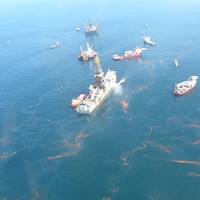
The National Oceanic and Atmospheric Administration (NOAA) reported that results to a new study conducted by a team of NOAA and academic scientists suggest that crude oil from the 2010 Deepwater Horizon disaster causes severe defects in the developing hearts of bluefin and yellowfin tunas. The findings, published in the Proceedings of the National Academy of Sciences on the 25th anniversary of the Exxon Valdez oil spill, show how the largest marine oil spill in United States history…





